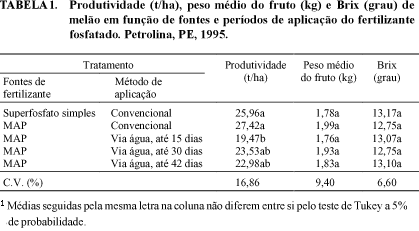This study was carried out at Petrolina, PE, Brazil, with the objective of evaluating the effect of two sources of phosphorus applied conventionally and through trickle water irrigation on melon (Cucumis melo L.), cv. Valenciano Amarelo. The experiment was run in a randomized complete blocks design, with four replications and five treatments: 1. simple superphosphate; 2. monoammonium phosphate (MAP) applied conventionally; 3. MAP applied through trickle water irrigation up to 15 days after germination; 4. MAP applied through trickle water irrigation up to 30 days after germination, and 5. MAP applied through trickle water irrigation up to 42 days after germination. All the treatments had the same amount of phosphorus (120 kg/ha of P2O5) according to soil analysis. The highest commercial fruit yields were obtained with MAP and simple superphosphate applied conventionally (27.42 and 25.96 ton/ha, respectively), not differing from MAP applied through trickle water irrigation up to 30 and 42 days after germination, but surpassing the yield of 19.47 ton/ha obtained with MAP applied through water irrigation up to 15 days after germination. It was found that the sources of phosphorus and ways of application did not influence on the mean weight of fruits (1.86 kg) and on the soluble solids content at harvest time, which varied from 12.75 to 13.17ºBrix.


